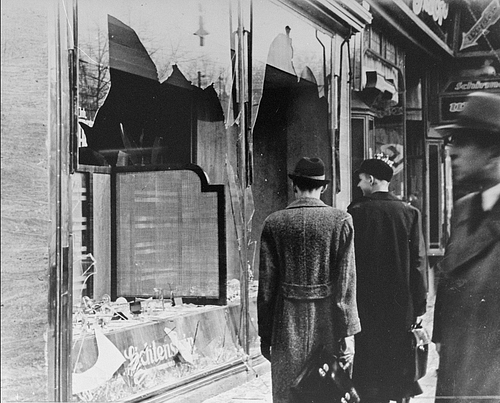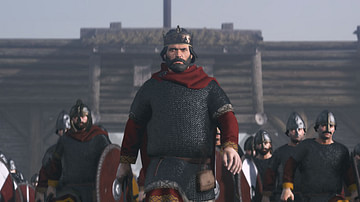
Alfred Rosenberg (1893-1946) was an Estonian-born Nazi who propounded anti-Semitic racial theory and anti-Christian values. Rosenberg's theories matched those of the leader of Nazi Germany Adolf Hitler (1889-1945) and were used to justify attacks on Jewish people, Communists, and homosexuals, amongst many others.
Rosenberg was also Hitler's minister of the Eastern Occupied Territories during the Second World War (1939-45), where his crimes included the use of child slave labour. Rosenberg's career as a Nazi administrator, though, was often overshadowed by more ambitious rivals who ensured he remained only a figurehead of certain Nazi cultural institutions, such as those which systematically stole works of art from occupied Europe. At the Nuremberg trials of 1945-6, Rosenberg was found guilty of war crimes and crimes against humanity and hanged.
Early Life & Anti-Semitic Works
Alfred Rosenberg was born on 12 January 1893 in Tallinn, Estonia (then called Reval and part of the Russian Empire). Rosenberg's parents belonged to the large German-speaking immigrant community in Estonia; his father was a shoemaker. Despite Rosenberg being hypernationalistic towards Germany – he joined a pro-German group as a student – his ancestors may have been Estonian, and the Rosenberg name was actually an adopted one, ironically, given future events, one with Jewish associations.
Rosenberg studied architecture at Riga's Technical Institute and then moved to Moscow, where he perfected his Russian, married a fellow student called Helga, and experienced the February Russian Revolution firsthand. He ultimately received a diploma in architecture in March 1918. Rosenberg also saw the events of the October Revolution. Not directly involved in either revolution, Rosenberg was staunchly anti-Bolshevik and made several public speeches to that effect. Rosenberg, along with many other anti-Bolsheviks, decided to move to the safety of Paris. It was in France that Rosenberg first began to read about racial theory, examining the works of such authors as Arthur de Gobineau (1816-1882) and Houston Stewart Chamberlain (1855-1927), both of whom believed in a Nordic super race, to which all other races were regarded as inferior.

In December 1918, Rosenberg moved to Munich, earning a little money as a painter. Here, Rosenberg wrote several articles against Jewish people and Communists, which he classed as essentially the same enemy in one, often referring to the Russian Revolution, for example, as being carried out by "Jewish Bolshevism" (Gellately, 48). Rosenberg wrote his first book in 1920, The Track of the Jews through the Ages, in which he presented his rather inconsistent ideas that Jews were behind both capitalism and Bolshevism and were intent on destroying culture and morality wherever they lived.
Rosenberg was a conspiracy theorist whose ideas were often based on fake research presented by others. Jews were not, as Rosenberg presented, benefitting from the Bolshevik Revolution but were one of its greatest victims via a series of vicious pogroms. Rosenberg's ideas were often based, too, on inaccurate statistics, such as how many Soviet Commissars were Jewish, and on misinformation, for example, that US foreign aid was only ever given to Jews. Rosenberg remained convinced that Jews were working together in an international conspiracy to take over the world. At this stage, Rosenberg did not call for the extermination of the Jews but did want their complete removal from any and all political, economic, and cultural activities in Germany. These extreme ideas tapped into a Germany beset by economic problems such as hyperinflation in the years after the First World War (1914-18). The extreme ideas were taken up by many ordinary workers who thought they saw links (where there were, in fact, none) between the rise of Communism and Germany's high unemployment and economic stagnation. This was an interpretation of events which was even more widely held after the Great Depression of 1929. In short, Rosenberg's writings and speeches gave people an easily identifiable scapegoat for all their woes: Jewish people.
Rosenberg met the far-right would-be politician Adolf Hitler, and the two became close associates. In 1919, Rosenberg joined the new fascist National Socialist German Workers' Party (NSDAP or Nazi Party for short). Rosenberg got a job as the editor of the official weekly Nazi newspaper, Völkischer Beobachter; he impressed and became the paper's managing editor in 1923. This newspaper was packed with Nazi propaganda, stoking up hatred of Jewish people, Communists, and anyone else the Nazis did not like. Rosenberg's "continuing conspiracy tales fueled the vicious streak in National Socialist antisemitism" (Gellately, 51). The tall tales also identified the USSR as an enemy of Germany since Rosenberg insisted the Bolsheviks were intent on expansion and attacking Western Europe. These ideas fitted well into Hitler's plans to represent the Nazis as the true defenders of Germany.
Nazi Party Roles
Rosenberg, with his experience of living through both of the Russian revolutions, was able to give information on ongoing events in that country and encourage Hitler's desire for his own violent seizure of power. Indeed, Hitler orchestrated the Beer Hall Putsch of November 1923, but this ended in complete failure and imprisonment. During his one year in prison, Hitler wrote a book, Mein Kampf or 'My Struggle'. In this work, and probably thanks to daily visits from Rosenberg, Hitler incorporated Rosenberg's anti-Semitic ideas into a theory where German Jews were identified as enemies of the state and the main reason Germany was not fulfilling its full potential. Hitler suggested this potential would only be achieved if the country were governed by pure-blooded 'Aryan' Germans (see below), though the top Nazis were often far from being members of this select physical group themselves.
While Hitler and other senior Nazis like Rudolf Hess (1894-1987) were in prison, Rosenberg took over leadership of the Nazi Party, even if it was officially banned. Rosenberg was not popular with the party faithful, though, and he was obliged to move aside. Rosenberg's rivals in the Nazi party frequently joked that he was the only Aryan Rosenberg in the world. Rosenberg continued to publish anti-Semitic literature where Jews were accused of conspiring together for world domination. It was also in 1923 that Rosenberg divorced Helga, but he married again and had a daughter.
Hitler was released in December 1924, but Rosenberg, having once been very close to the leader, gradually found himself further and further away from Hitler's inner leadership group and the decision-making processes within the Nazi movement. Nevertheless, Hitler always remained loyal to one of his oldest comrades and continued to give Rosenberg positions of secondary importance. He was appointed the head of the National Socialist Society for Culture and Learning in 1927. In 1928, this organisation changed its name to the Fighting League for German Culture. Rosenberg soon came off second best in this specific area of Nazism to the minister of propaganda Joseph Goebbels (1897-1945). Rosenberg was influential in the German Faith Movement, a pagan alternative to the dominant religion in Germany, Protestantism. However, once again, Rosenberg's ambitions were curtailed by others, in this case, Hitler himself since the leader did not want to alienate Nazi supporters in the Christian Church.

Myth of the Twentieth Century
Rosenberg's major work on what the Nazis described as the 'Jewish Problem' was his book Myth of the Twentieth Century (Der Mythus des Zwanzigsten Jahrhunderts), published in 1930. The book was popular, with two million sales, perhaps precisely because the Catholic Church put it on its index of forbidden books (because of its anti-Christian content). However, the book's disjointed prose made the ideas therein very difficult to follow. As one historian notes, "few managed to read it beyond the first chapter" (Cimino, 41). Albert Speer, Hitler's chief architect, described Rosenberg's work as simply "unreadable" (Speer, 149). Even Hitler described the book as containing "stuff nobody can understand" and stressed that it should not be regarded as an official book of Nazi Party thinking. Hitler described Rosenberg as "a narrow-minded Baltic German who thinks in horribly complicated terms" (ibid, 150). Nevertheless, Myth contained many essential ideas that matched those that Hitler had presented in Mein Kampf.
Rosenburg did not present anything especially new in his book but collected together various bigoted ideas about race and empire-building, which extreme right-wing groups had been extolling since at least the 19th century. The author also blended a mishmash of pseudo-science and the history of civilizations, ancient and modern, real or imagined. Rosenberg rejected both democratic and liberal values, replacing them with a dictatorial system where a race of 'supermen' ruled over the inferior races. The 'supermen' were 'Aryans', a rather vague term the Nazis used to refer to groups such as the Nordic peoples. Rosenberg considered the elite 'master race' as being the Germanic 'Aryans'. In contrast, Jewish people and Black people were put at the very bottom of Rosenberg's social scale.
According to Rosenberg, the 'supermen' were to be made even stronger through their constant struggle with other races and nations. War, then, is a necessary and constant struggle to achieve supremacy. Above all, the 'supermen' must fight to control the Jewish people since they are, according to these theories, most responsible for society's decline and the stagnation of the world economy. In addition, Rosenberg repeats the idea of Lebensraum ('living space') discussed by Hitler in Mein Kampf, that is, the perceived necessity to conquer territory of the USSR so that Germanic peoples can live there and exploit the region's wealth of natural resources.
Rosenberg's ideas provided a foundation upon which the Nazis built terrible edifices responsible for the destruction of others. This despite the fact that Nazi race theory is full of holes, errors, and inconsistencies. Nazi race theory "can be seen as a mere propaganda gloss for a political strategy that was opportunistic or shaped by circumstance" (Dear, 608). Or, to put it another way, Rosenberg "sought to make National Socialist theory appear to be the result of genuine research and science, rather than the product of hate" (Gellately, 52).
Nazi race theory was presented to children through education activities and to adults via propaganda in print, radio, and film. The theories were then used to justify many actions ranging from the invasion of the USSR to the euthanasia of those with physical and mental disabilities to the Holocaust and murder of 6 million Jewish people.

Role in Foreign Affairs
In 1930, Rosenberg was elected to the Reichstag, the German parliament. He concentrated on foreign affairs, particularly relations with Britain and Italy. The fascist regime of the latter was friendly enough, but British diplomats failed to be won over by Rosenberg's amateurish approach and anti-Semitic theories: "Rosenberg's goodwill mission to England in 1933 reinforced British repugnance toward the Third Reich" (Boatner, 474).
By mid-1933, after Hitler had established a fascist dictatorship in Germany, Rosenberg became head of the Nazi foreign affairs department. Rosenberg's ambitions in the foreign office were, however, curtailed by the more able and ambitious Joachim von Ribbentrop (1893-1946), who went on to serve as the Nazi minister of foreign affairs (1938-45), a position Rosenberg had dearly coveted. Rosenberg had to look to some other area of Nazism. Accordingly, in January 1934, he oversaw a new project of indoctrination when he was given the title: 'The Führer's Delegate for the Entire Intellectual and Philosophical Education and Instruction of the Nationalist Socialist Party' (one sympathises with the sign-writer who had to update Rosenberg's office door). This would, amongst other projects, lead Rosenberg to found the Central National Socialist University, which taught students Nazi ideology and which contained research offices that endeavoured to find spurious physical evidence to support such theories (thousands of skulls of Jewish people were measured, for example). Another of Rosenberg's institutions, opened in March 1941, was the Frankfurt Institute for the Study of the Jewish Question.
The Administration Staff Rosenberg
As Germany attacked other countries, Rosenberg was made the figurehead of a special Nazi department that was directed to acquire objects of cultural significance in occupied territories. In defiance of the Hague Convention, which prohibited looting in wartime, the Administration Staff Rosenberg (Einsatzstab-Reichsleiter Rosenberg or ERR) steadily acquired throughout WWII thousands of fine paintings, sculptures, furniture items, books, and archival documents, all to be squirrelled away by the Nazis for storage, public display in such major new museums as those built in Berlin and Linz, or to adorn private homes such as those of Hermann Göring (1893-1946), who really ran the ERR. Museums, palaces, and private residences were plundered across Europe. The excuse was that these items were safer in Germany, and there were even claims that the objects were made by a German artist or were inspired by Germanic culture.
In occupied Western Europe, art objects were typically paid for using devalued Reichsmarks, while in occupied Eastern Europe, they were usually just stolen, although the Nazis' love of documentation often meant a receipt was given anyway. Many museum workers kept secret records of the works that had been stolen. Rosenberg's project did benefit some ordinary Germans since more mundane items of furniture taken from occupied territories were distributed to households which had suffered damage in the Allied bombing of Germany.
Despite the success in tracking down thousands of stolen works by such units as the Allied Monuments, Fine Arts, and Archives teams, unfortunately, countless important works were lost to the public forever, a famous example is Portrait of a Young Man by Raphael (1483-1520), assumed to be in someone's private collection today.
Return to Foreign Affairs
In 1943, Hitler made Rosenberg Reich Minister of the Eastern Occupied Territories, which was actually two areas: the Reich Commissariat Ostland and the Reich Commissariat Ukraine, which, together, covered Ukraine, part of Belarus, part of eastern Poland, and the Baltic states. Rosenberg, despite his theories on race, tried to avoid the usual treatment of eastern populations which came under Nazi rule, that is expulsion and mass murder. Rosenberg attempted to gain the support of local peoples in order to make them allies and have them fight the USSR's Red Army. Nevertheless, Rosenberg still imposed such measures as forced labour for children aged 10 to 14. In many areas of policy, Rosenberg was overruled by others since he did not fare well against Nazi rivals who were more talented at administration and much more ruthless. In Ukraine, for example, Rosenberg's power was completely usurped by Erich Koch (1896-1986), the Reich commissar. More generally in the East, Rosenberg found himself subordinate to the leader of the SS, Heinrich Himmler (1900-1945). Unable to find a niche for himself in the usual Nazi mess of overlapping and competing organisations in the East, Rosenberg wrote a letter of resignation directly to Hitler in October 1944, a letter which received no reply.
Nuremberg Trials & Execution
Rosenberg was tried as a war criminal along with other senior Nazi figures in the post-war Nuremberg trials. He remained unrepentant of his views on race, giving extremely long-winded and incoherent answers when questioned in the defendant's dock. As one weary journalist wrote in the Manchester Guardian, "For hours he maundered on. It was no more possible to grasp what he was saying than to seize a handful of cloud" (MacDonald, 113). Rosenberg claimed that Hitler and others had taken his ideas to justify genocide when he himself had wanted a more moderate policy of forced emigration of Jewish people to such isolated places as the island of Madagascar. The prosecutors, though, focussed on his role as Reich Minister of the Eastern Occupied Territories. Rosenberg was found guilty of all four charges: conspiring to cause war, crimes against peace, war crimes, and crimes against humanity. Alfred Rosenberg was sentenced to death and hanged on 16 October 1946. His remains were scattered on the estuary of the Isar River in Germany.







